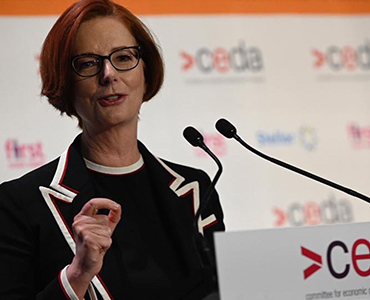Putting a price tag on human life may appear insensitive but it is also practical… some would say necessary… and it has been done for centuries by businesses, governments, public authorities, courts and insurers, Beyond Blue Chair and former Prime Minister of Australia, the Hon. Julia Gillard AC, told CEDA’s State of the Nation audience.
 “Could we ever put a dollar figure on the value of a happy life? Probably not, but, we do have some numbers that help us see the economic differential between a lifetime of good mental health and participation, compared to one of poor mental health and lost opportunity,” Ms Gillard said.
“Could we ever put a dollar figure on the value of a happy life? Probably not, but, we do have some numbers that help us see the economic differential between a lifetime of good mental health and participation, compared to one of poor mental health and lost opportunity,” Ms Gillard said. 
“Poor mental health imposes costs estimated at $60 billion annually on individuals and their families, workplaces, the health and welfare systems, and has economic consequences in the areas of justice, aged care, housing and education.
“The annual cost of poor mental health to the economy is about four per cent of GDP.
“Eight million working days are lost due to mental ill health in Australia each year.
“But we also have some benefit numbers.
“Very recent economic modelling by Deakin Health Economics, commissioned by the National Mental Health Commission, shows investment in mental health prevention initiatives yields substantial positive returns.
“The study looked at 10 interventions with lifespans of three to 11 years, targeting workplaces, e-health for anxiety disorders in young people, depression in new mothers, and loneliness in seniors.
“Nine of these interventions produced positive returns on investment, with savings in productivity and health care costs estimated at almost $290 million overall.
“KPMG’s 2018 Investing to Save report, commissioned by Mental Health Australia, found investing $50 million in prevention and early intervention priorities could achieve $442 million in long-term savings to the national economy.
"These are numbers we should all get behind.
“At Beyond Blue we are certainly motivated by them. Prevention and early intervention are our watchwords.
“I know from my former life in this place (Parliament House) that windows of opportunity, like the ones we have now, don’t stay open for long.
“So now is the time to be delivering clear messages about priorities in the reform agenda.
“At this stage of the discussion, I want to highlight the following three headline points.
“First, we need to design the system around people, not build a new system and then hope they will come.
“Consider a farmer who finds himself increasingly thinking about suicide as he shoots starving stock on a drought ravaged run or a female city office worker who has the same kind of thoughts during what she had hoped would be the happiest time of her life following the birth of her first child; from a clinician’s point of view both individuals would be in a similar state.
“But we all know that the best way to get help to these individuals is very different.
“We can learn a great deal by genuinely listening to people as they tell us what they need.
“Then in rolling out tailored supports we must overcome the inequity between the prevalence of mental health conditions and provision of services.
“We require more e-health and telehealth initiatives to reach out from better resourced metropolitan areas into regional, rural and remote regions where access to support is often patchy, or non-existent.
“Second, there is a need for more low-intensity or community care options to expand prevention and early intervention before the intensity of a hospital emergency department is required. It is unsurprising that this is a problem given the Federal Government generally funds primary care and state governments administer our public hospitals, leaving no clarity about who should be doing what in the space in between.
“Third, we must think differently about workforce and equally value clinical and non-clinical or psychosocial services that are easily accessed and appropriately funded.
“This will require a shift and re-imagining of our structures to look beyond hospitals and health services.
“It’s about GPs, allied health professionals, psychologists and psychiatrists, peer workers and coaches, workplaces and schools working in collaboration to design programs for individuals, families, communities.
“If these reform directions were pursued, we would be able to build an agile system that acknowledges the ebbs and flows of an individual’s mental health over a lifetime, so the level of care can be stepped up or down; can be matched to the nuance of need.
“How do we get to this kind of profound change?
“Fortunately, the Commonwealth has already indicated its willingness to work with the states and territories on system reform over the next two years, an openness to collaboration that is welcome.
“COAG has agreed that individual jurisdictions would take a lead on piloting specific initiatives and sharing best practice. They committed to working together to develop practical options to ensure that the right support is available to individuals, families and communities, at the right time and in the right place, drawing on existing community expertise.
“COAG’s focus on mental health and suicide prevention is a step in the right direction.
“But we must ensure we don’t get lost yet again in individual initiatives at the risk of missing the opportunity for coordinated and broad-ranging national reform. For structural system reform that will change the face of mental health policy in Australia for generations to come.”